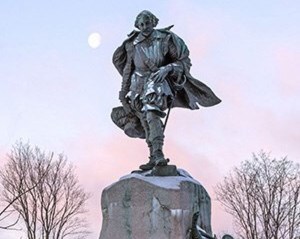OrilliaMatters received the following letter to the editor from Keith Doxsee, Grand Chief, Montagnais Metis First Nation, regarding our recent article about having your say on the future of the Champlain Monument.
********************
The public consultation is flawed since the working group does not include Metis. Metis can have their say, by following the public process, but the message is clear. Metis are second class Indigenous people in the eyes of Parks Canada and the City of Orillia.
It’s important to recognize Metis are not limited to citizens of Metis Nation Ontario.
Metis are members of other representative organizations, local communities like the Montagnais Metis First Nation, or individuals or families without membership in any community. They are all Metis. They may be your neighbour.
Metis are not a small group. In 2016 Statistics Canada reported there were 587,545 Metis in Canada and 20.5% lived in Ontario. Simcoe County reports over 50% of Indigenous people in the County are Metis.
The mandate of the working group is to prepare a plan that is “respectful and representative of both Indigenous and non-Indigenous perspectives”. How is ignoring Metis respectful? How can the working group claim to be representative by excluding a significant portion of the Indigenous community?
Champlain was an important figure to Metis and an advocate of mixed Indigenous/European marriages. He formally affirmed this to a gathering of Indigenous chiefs in 1633 and 1635 when he said "our young men will marry your daughters, and we shall be one people.”
It is a pivotal statement documenting the Crown’s official policy, of accepting intermarriage of Europeans and Indigenous people, and marking a point in history where Metis were officially recognized by the Crown.
When Champlain arrived in 1615 he was not the first European to visit the area. He recorded encountering 13 or 14 “Frenchmen” in Attawandaron territory (which was in Southern Ontario) in mid-August 1615. It is possible these people were Metis from the East Coast who were already trading in the area.
During a 1976 excavation of an Attawandaron burial site in Southern Ontario researchers concluded at least one of the human remains was “clearly of mixed parentage”. The burial site was dated in the mid 1650s so this person was likely conceived in the period from 1600 – 1630.
Not only were Metis and French people doing business before Champlain arrived they had established relationships with Indigenous women and fathered Metis children.
The Elementary Teacher’s Federation of Ontario (“ETFO”) is a member of the working group. They recognize the diversity of Indigenous people, and the need to dispel myths and misconceptions, in this policy statement:
“It is our hope to educate and inform ETFO members on the diversity of indigenous peoples in Canada, provide information on the complex historical and current relationship between Canada and Aboriginal nations, and provide for dialogue to dispel common myths and misconceptions of Aboriginal peoples”
ETFO have the opportunity to educate and inform its members, and the general public, about Metis origins and the importance of historical figures like Champlain.
To create dialogue, and to be consistent with its stated principles, ETFO should insist on Metis participation in the working group as a condition of ETFO funding and participation.
Parks Canada have a stated policy “to provide a consistent approach for Indigenous engagement and relationship building”.
The policy is primarily directed at Indigenous participation in National Parks but, since Parks Canada have custody and control of the Champlain monument, those same principles should be applied to the working group.
Three of the principles are based on partnership, respect and support but are glaringly absent when it comes to Metis.
The City of Orillia have “partnered” with Parks Canada. Since the working group is not a committee of Council, and the monument is not a municipal asset, the City seems more of a participant than a partner. If the City were a true partner it would have insisted on including Metis in the working group.
Most Canadians support the principle of inclusiveness and treating Metis as second class Indigenous people is out of step with Canadian values.
Leaders in unions, government and business should advocate for removal of barriers to Metis participation rather than building new ones. The working group is a good place to start.
Keith Doxsee
Grand Chief, Montagnais Metis First Nation
********************



